Taj Mahal
kjohri | Dec 07, 2010 | Comments 3
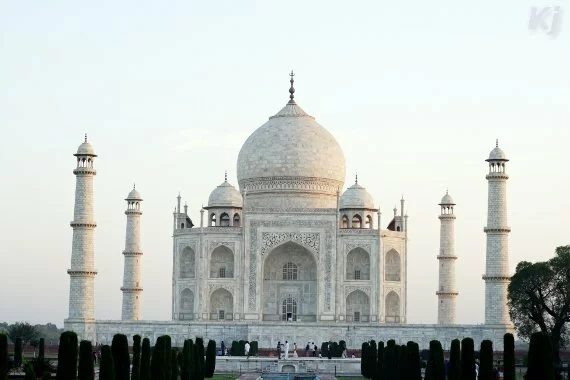
Taj Mahal, Agra
Taj Mahal is a mausoleum built by the Mughal emperor Shah Jahan for his wife Mumtaz Mahal. Taj Mahal is one of the seven wonders of the world. It is visited by more than 11,000 tourists on an average day; the number of tourists for the year 2009 has been reported to be more than 3.5 million. Located in the city of Agra in India, Taj Mahal became a UNESCO World Heritage Site in the year 1983. It is open to tourists from sunrise to sunset on weekdays, Saturday through Thursday, being closed for tourists on Fridays.
TAJ MAHAL HISTORY
Mughal emperor Shah Jahan ruled from 1627 to 1658. Shah Jahan was the son of Jahangir and grandson of Akbar the great. In the year 1607, Shah Jahan, then known as Prince Khurram, married Arjumand Banu Begum, daughter of Abdul Hasan Asaf Khan, Governor of Lahore under Emperor Jahangir. Abdul Hasan Asaf Khan was the brother of Nur Jahan and the son of Mirza Ghiyas Beg, an important official under emperors Akbar and Jahangir and better known as I'timād-ud-Daulah, a title meaning a Pillar of the State
. After marriage, Shah Jahan gave her the title of Mumtaz Mahal, which meant the Jewel of the Palace
.
Unlike her aunt Nur Jahan, who played an active political part in Jahangir's rule, Mumtaz Mahal concentrated on providing strong family support to Shah Jahan. She accompanied Shah Jahan on his military expeditions. The couple had fourteen children. It was during the birth of the fourteenth child on June 17, 1631, a daughter named Gauhara Begum, that Mumtaz Mahal died. Gauhara Begum, however survived her mother's tragic death and went on to live for next seventy five years.
Mumtaz Mahal's untimely death left Shah Jahan grief-stricken. But, apparently, he handled his grief in a constructive manner and went about building a mausoleum for Mumtaz Mahal which would become one of the most well known structures for centuries to come. The construction was started and it took about seventeen years to complete the monument in 1648 at a cost of about 40 million rupees. The cost of gold was about Rs 15 per tola (11.66 grams) at that time. Ustad Ahmad Lahori was the chief architect of the project. He was helped by Ustad Isa Afandi, who prepared the site plan. About twenty thousand artisans worked to complete the construction. The white marble came from Makrana, Rajasthan. As it was a big project, the work got completed in stages, and there are varying records of the date of completion. The years mentioned for completion
range from 1647 to 1653.
In the year 1658, Shah Jahan's son, Aurangzeb deposed him and became the emperor. Shah Jahan was put under house arrest in the Agra Fort. Shah Jahan died in 1666. After his death, he was buried next to Mumtaz Mahal in the Taj Mahal.
DARWAZA-I RAUZA
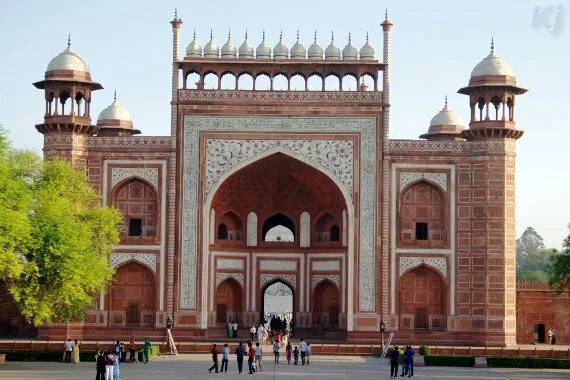
Gateway to the Taj Mahal
The main gateway, called Darwaza-i Rauza or the Great Gate
is on the southern side. It is predominantly a red sandstone structure with white marble used in the arches and domes. The decorations on the arches and the calligraphy is similar to that on the main monument.
TAJ MAHAL
As soon as one crosses the Darwaza-i Rauza, one sees the full view of Taj Mahal, facing the inner side of Darwaza-i Rauza, about 200 meters away. It is a unique sight; the sheer beauty of the monument takes ones breath away.
Leading to the Taj Mahal there are two longitudinal water pools on the north-south center line. There is a raised marble water tank in between the two pools. The pools form the center line of a big garden with Taj Mahal and Darwaza-i Rauza at the two ends. The pool closer to the Taj Mahal shows the reflection of the Taj Mahal in water.
The Taj Mahal, with reflection in the pool
Taj Mahal, a closer view
Taj Mahal's three dimensions, length, width and height, are all about 55 meters. Its plan is a square with chamfered corners, making it an unequal octagon. The larger side of octagon is 55 meters. The minarets are 44 meters tall. Taj Mahal is highly symmetrical. The facades on the four sides are exactly the same. You can see the Taj Mahal from any direction; all views exactly the same. The main pattern on each large side is an arch, with floral design on top and a screen below. This pattern is repeated on the left and right sides of the main arch and also on the smaller vertical sides of the monument. There is a mosque west of Taj Mahal and an assembly hall, called Mehmaan Khana on the eastern side. Both the mosque and the assembly hall have exactly the same external appearance, reinforcing the concept of symmetry in architecture.
Inside the Taj Mahal, the tomb chamber is octagonal with marble screen making a boundary around the cenotaphs. Mumtaz Mahal's cenotaph is at the center of the chamber. Shah Jahan's cenotaphs is besides Mumtaz Mahal's on the western side. This is the only asymmetrical visual detail in the entire Taj Mahal. The actual graves are in a simpler rectangular chamber below.
One of the most striking features of Taj Mahal is the beautiful calligraphic work on the sides and also on the cenotaphs. The text for calligraphy is from the Holy Qur'an.
There are beautiful decorations and carvings at many places. Some of these are shown in pictures below.
PICTURES
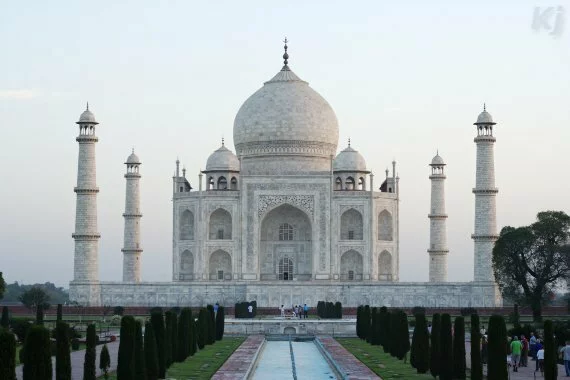
Taj Mahal, another view
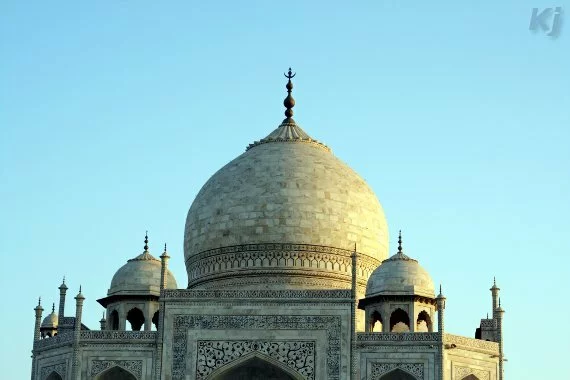
Taj Mahal dome closeup
A minaret of the Taj Mahal
”
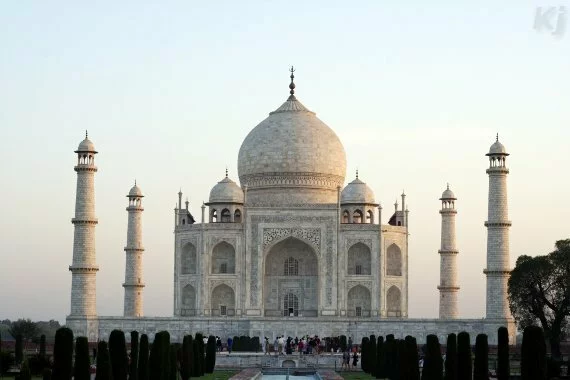
Taj Mahal, another view
Taj Mahal, another view

Random Quotes: Read, search and share quotations.
-
http://www.tajvoyageindia.com/ Lorène
-
Dereq Laureta Manuel
-
Aaron Nevels